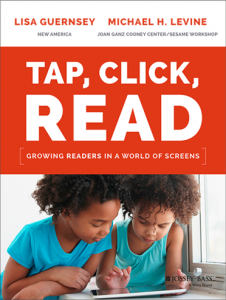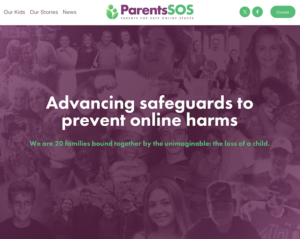Guest Blog by Kathy Kleckner
 Children’s reading is reduced to little more than a pipeline for profits in a new book from Lisa Guernsey and Michael H. Levine, employees of think tanks funded by technology corporations and devoted to children as consumers of technology.
Children’s reading is reduced to little more than a pipeline for profits in a new book from Lisa Guernsey and Michael H. Levine, employees of think tanks funded by technology corporations and devoted to children as consumers of technology.
At the outset, the authors admit that their book, Tap, Click, Read: Growing Readers in a World of Screens is not about how children learn to read or how to teach children to read. Indeed. Their book is about promoting a new definition of literacy, an “uberliteracy,” that diminishes the importance of literature (the book), marginalizes the mutually reinforcing relationship between reading and the adult-child bond and abandons the goal of fostering a love of reading – all in exchange for increased dependency on technology use.
Guernsey and Levine articulate their vision of a new literacy in what they call “Readialand”, a fantasy based on their values and goals to describe an “uberliterate” future. In Readialand, reading becomes a soulless routine of staring into and touching screens, not an enjoyable experience in its own right; technology use is continuous, all human interaction is mediated by it. Having a book and reading it, or using a library are presented as mere possibilities via technology. It’s not even clear if text exists in “Readialand”, or if, in fact, reading is based entirely on pictography (icon choices). “Readialand” is an appropriately childish term used to describe an infantile experience without depth, effort or independence — where technology carries you around all day long, always “engaging”, unconsciously sad.
Currently, we place reading at the center of literacy, and technology is on the periphery, if it appears at all. In Readialand, technology is at the center of literacy, while reading is peripheral, if it happens at all. Readialand is the technology industry’s dream. Its realization as a common experience represents fortunes to be made by technology corporations at the expense of literacy and literature.
Only glancingly does this book about “growing readers” specifically consider literature and a child’s engagement with literature — and not because the authors regard literature as crucial and central in the development of a reader. They do not. It arises only incidentally when, for example, the “chief content officer” of an e-book corporation uses a piece of literature, the nursery rhyme, “Humpty Dumpty”, in an e-book.
“Humpty Dumpty” is powerful for developing language through rhyme, but it also contributes to the social and emotional development of children. It’s an age-appropriate introduction for very young children to facts of life such as mortality, vulnerability, consequences, and the fact that some events do not end well and some problems cannot be fixed. All of this is lost on Guernsey and Levine. They want us to know that “an educational media expert” has taken this nursery rhyme and added the much-touted, touch-screen “interactivity” that here allows a child to transcend all the king’s horses and all the king’s men to reconstruct Humpty Dumpty with a few taps of the fingers. With a few taps, meaningful lessons are displaced by a stunning refocus of the story toward narcissism. Rather than presenting this as an example of how destructive and infantilizing technology use can be, Guernsey and Levine say this e-book works to “assist with meaning” and “to empower children”, all under a nonsensical heading: “Supporting Children’s Comprehension of the Plot”.
An important, stated belief in Tap, Click, Read is that technology is urgently needed to mitigate inequality. The authors say that poor children are getting “the short end of the stick” and “we cannot afford to ignore the affordances of technology, especially for disadvantaged children.” How exactly is technology related to advantages and disadvantages for children age 0-8? We are never told. Perhaps the only problem is that technology corporations have not yet accessed tax dollars to penetrate the market of poor people for technology consumption and maximizing corporate profits. This suspicion is confirmed when Guernsey and Levine point us to online preschools for poor children – 15 minutes a day on a computer. Online preschools. Here the authors apply a very old, inequality-entrenching, education policy standard: What never gets prescribed to wealthy children is exactly what poor children should have. Online preschools are wretched experiences for children, but they represent a gold mine of tax dollars for technology corporations. An important purpose of this book is to convince us that technology-based strategies are the only way or the best way to help poor kids read. Without data or comparative analysis, it is more accurate to say that the book wants us to think that tech solutions simply are, unthinkingly, the way.
Guernsey and Levine pose a number of important questions and concerns about technology use that encourage the reader to trust them. For example, they ask the most important question facing us: Is the enormous increase in the amount of time children spend with screens related to the ongoing decrease of time children spend reading? They recognize that there is a lack of conclusive research to tell us about the relationship between these changes. But rather than considering closely the research that does exist or calling for more research and due caution, they pre-emptively answer this question with a sweep of cynicism: We should not expect that parents spend time away from screens doing the activities proven to support early literacy skills, child development and family bonds (i.e. ECRR2) because there have always been parents “behaving inappropriately” and we would be wrong to assume that parents would want or do what their children need away from screens. A fundamental purpose of Tap, Click, Read is to lower our expectations about poor families benefiting from books and reading the way wealthy families often do then funnel what remains through — not away from — screens.
The chapter, “Why Adults Still Matter Most” focuses on adults as “guides on the side”, supplying and enabling technology consumption. The authors suggest that adults are to exist at a “new level”, doing for children only what computers cannot do. Adults still matter most for no other reason than because computers have not entirely replaced them. Accordingly, they state that “children who interact with technology while working with adults who can set good examples and guide them to new heights are receiving tremendous advantages.” This would be good if it were true. But no part of this claim is defined, explained or substantiated. They tell us
we should thrill in the adventure of the unknown, the “dazzling promise”, the “wonders of digitization”. They ask us to be disinterested in facts, pay no attention to human relationships and, instead, embrace a dream. Chapter by chapter, Guernsey and Levine drag the advertising industry’s old burden: create demand for things we don’t need and shape what people think they want.
In lieu of data or solid analysis to persuade, Tap, Click, Read is an elaborate marketing piece that relies on the language and techniques of advertising to sell ideas. Instead of outcomes predicted by research, they continually refer to “possibilities” and “potential’; strangely using terms like “literacy opportunities” instead of “reading”. Sunny optimism stands in for facts, and speculation is repeatedly referred to as “expertise.” In a spectacular collapse of the distinction between marketing and objectivity, they include an evaluation of apps that relies solely on the claims made by companies that profit from them. Tap, Click, Read is most grim where it dilutes the love of reading –critical to literacy and the future of the book– into a Pavlovian framework, (“motivation to read and learn”) centered on commercial characters, electronic badges and data collection.
A few bright spots in the book consider technology applications created for and used by parents. There is a texting service, for example, that encourages parents to play and talk with their children. Ironically, technology might help parents remember what technology overuse has caused them to forget.
This book is most valuable for studying how the ‘battle” between human and machine is not real, but the battle between humans and the corporate agenda is all too real. The Seattle Public Library recently got a black eye when its $2 million dollar marketing plans veered too far from public service into corporate culture that their public found “sleek, soulless and sad”. Libraries beware. Tap, Click, Read is ubersleek, ubersoulless and ubersad.
Librarians looking for a new, research-guided book that centers on what children need to become readers, human concerns and gives due consideration to current technologies, see the excellent, Raising Kids Who Read: What Parents and Teachers Can Do by Daniel T. Willingham.
###
Kathy Kleckner has a Masters Degree in Library and Information Science from Dominican University and has served as a public librarian in Minnesota for 12 years. She is passionate about the science of supporting early literacy skill development, the love of reading and the parent-child bond. She believes that the parent-child bond is critical to supporting all children’s learning through all stages of development and is deeply concerned about technology use weakening that bond to the detriment of children, literacy and family life.



